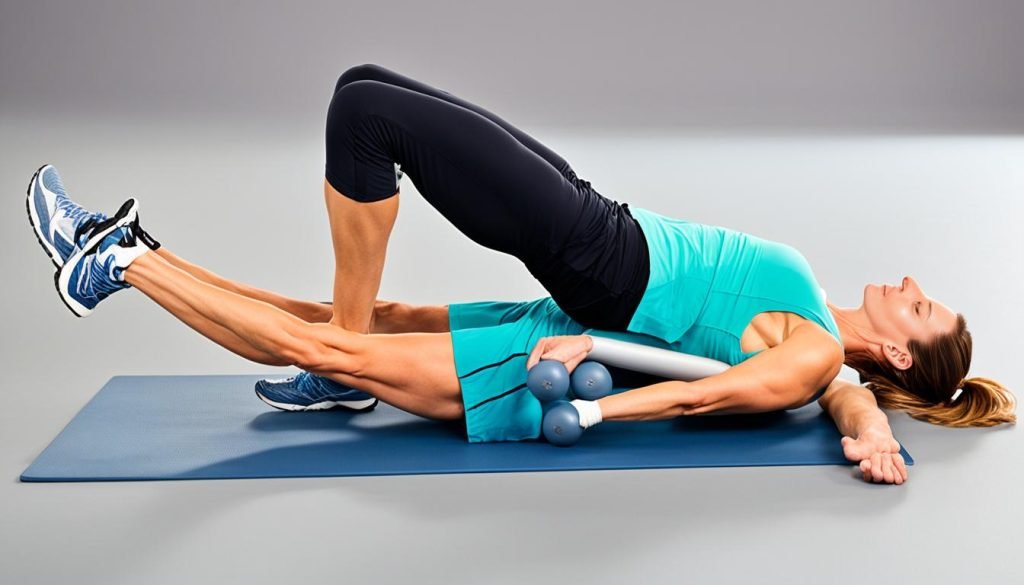Have you ever seen someone easily reach up high while you struggle with everyday tasks? It might be because they have better shoulder mobility. Having flexible shoulders is key for athletes and everyday people alike. It helps improve how well you move, keeps your posture right, and lowers the chance of getting hurt. We'll show you easy tips and exercises to make your shoulders more flexible. These will help you move better and stay healthy.
Key Takeaways
- Flexible shoulders are essential for improved daily performance.
- Shoulder mobility contributes to better posture and reduces injury risk.
- Joint capsule flexibility is critical for overcoming movement limitations.
- Rotator cuff flexibility plays a significant role in overall shoulder function.
- Simple mobility exercises can dramatically enhance flexibility.
Why Shoulder Mobility Matters
Understanding the importance of shoulder mobility can greatly improve your life. A well-moving shoulder joint is key for doing everyday tasks, like getting dressed or cleaning. It makes these tasks easier and helps you live a smoother life.
Importance for Daily Activities
Doing everyday movements needs your shoulders to move well. Simple actions like reaching or lifting require enough mobility to avoid pain. If your shoulders don't move well, you might use other joints too much, causing problems.
- Dressing and grooming, requiring overhead reach and arm movements.
- Cleaning tasks, that involve lifting and reaching.
- Sports like swimming, tennis, or basketball, needing dynamic arm motions.
Health Implications
Not moving enough can make your shoulders tight and uncomfortable. Physical therapists say that not moving your shoulders well can lead to injuries. It can also cause problems in your neck and back. Keeping your shoulders mobile helps prevent injuries and keeps your joints working right.
| Activity | Impact of Mobility | Potential Issues with Limited Mobility |
|---|---|---|
| Dressing | Facilitates ease of movement | Difficulty in reaching overhead |
| Cleaning | Allows fluid motion and coordination | Increased strain experienced during tasks |
| Sports | Enhances performance and reduces fatigue | Higher risk of injuries to surrounding areas |
Making sure to move your shoulders every day helps prevent injuries. It also makes your shoulders healthier. Small changes can make a big difference in how well you move and feel during different activities.
Understanding Flexible Shoulders
Learning about shoulder mobility and flexibility is key for good health and function. Shoulder flexibility means muscles can stretch without any blockages. Shoulder mobility lets the joint move fully in all directions. Knowing the difference helps fix tight shoulders.
Mobility vs. Flexibility
The shoulder is a ball-and-socket joint that moves a lot. But, people might not move it fully because of habits. For example, sitting at a desk for a long time or not staying active. It's important to know about both mobility and flexibility for healthy shoulders.
Common Causes of Tight Shoulders
Knowing why shoulders get tight helps fix the problem and improve flexibility. Common reasons include:
- Desk jobs that require extended sitting
- Repetitive movements frequently performed in certain professions
- Prolonged periods in poor postural positions
Spotting these issues is the first step to fixing tight shoulders and improving mobility.

| Cause | Description | Impact on Shoulders |
|---|---|---|
| Desk Jobs | Extended periods sitting at a desk can create tension around the shoulders. | Reduced flexibility and increased tightness. |
| Repetitive Movements | Jobs requiring the same shoulder actions can lead to overuse injuries. | Restricted range of motion. |
| Poor Posture | Non-neutral neck and shoulder positions contribute to muscle strain. | Increased tension and discomfort. |
Knowing how to fight these common causes can help improve shoulder mobility. This leads to better performance in everyday tasks.
Effective Shoulder Mobility Exercises
Adding shoulder mobility exercises to your routine helps with flexibility and reduces tightness. This part talks about dynamic warm-ups, strength exercises, and static stretches for better shoulder performance.
Dynamic Warm-Up Movements
Before starting any workout, a dynamic warm-up is key. Arm swings and shoulder pass-throughs get the shoulders ready for harder activities. These moves boost blood flow and increase joint movement.
Strength-Building Exercises
Exercises like high-to-low rows and reverse flies help stabilize and strengthen the shoulders. They improve muscle balance and help prevent injuries. Regular practice boosts performance in sports and activities.
Static Stretching Techniques
After exercising, static stretches are important for keeping shoulders flexible. Doing cross-arm and sleeper stretches helps with flexibility in the shoulder joint. These stretches reduce muscle tension and aid in recovery, keeping shoulders healthy.
Integrating Thoracic Spine Mobility
Thoracic spine mobility is key to a strong shoulder and thoracic connection. The thoracic spine, in the upper back, gives stability and flexibility. This is vital for the shoulders to work right. If the thoracic spine is stiff, it can make the shoulders move in ways they shouldn't, leading to injury and pain.
The Role of the Thoracic Spine
A flexible thoracic spine helps with everyday tasks and exercises. It makes sure the shoulders move right, which is important for reaching up, lifting, and rowing. Keeping this area mobile helps avoid shoulder problems and improves how the upper body moves.
Exercises to Enhance Thoracic Mobility
Doing thoracic exercises can wake up your spine and help your shoulders work better. Here are some exercises to make your thoracic spine more mobile:
- Thoracic Rotations: This exercise helps the upper back rotate, making it more mobile.
- Cat-Cow Stretch: A dynamic stretch that moves the thoracic spine in extension and flexion.
- Wall Angels: This helps improve shoulder mobility by working the scapula and thoracic spine when moving your arms.
- Foam Roller Extension: Using a foam roller to extend the thoracic spine can ease tightness and increase flexibility.
Adding these exercises to your routine strengthens your shoulders and improves your overall health. Focusing on thoracic spine mobility is key to better physical performance and injury prevention.

| Exercise | Target Area | Benefits |
|---|---|---|
| Thoracic Rotations | Thoracic Spine | Improves rotation and flexibility |
| Cat-Cow Stretch | Spine | Enhances flexibility and relieves tension |
| Wall Angels | Shoulders and Upper Back | Increases shoulder mobility |
| Foam Roller Extension | Thoracic Spine | Improves extension and decreases tightness |
Shoulder Impingement Prevention Strategies
Learning how to prevent shoulder impingement can greatly improve your shoulder health. It's important to know the risk factors for shoulder injuries that can lead to impingement. By understanding these risks and doing exercises to prevent them, you can keep your shoulder moving well and avoid injuries.
Identifying Risk Factors
Knowing what can increase your risk of shoulder injuries is key to preventing impingement. Some things make you more likely to get shoulder injuries, such as:
- Previous injuries: If you've had shoulder problems before, you're more likely to have them again.
- Improper lifting techniques: Lifting weights or doing activities with bad form can hurt your shoulder joints.
- Lack of mobility: Not having enough flexibility and strength in your shoulder and nearby muscles can cause imbalances. This makes you more likely to get impingement.
Preventive Exercises and Activities
Adding exercises to prevent shoulder impingement to your workout routine is key. These exercises help improve your shoulder's mobility and strengthen muscles that keep it stable. Here are some good ones to try:
- Shoulder Blade Squeezes: This exercise helps improve your posture and makes your shoulders more stable.
- Wall Angels: Doing this exercise against a wall opens up your shoulder area and makes it more mobile.
- External Rotations with Resistance Bands: This targets the muscles in your rotator cuff to make them stronger and more stable.

By taking these steps and doing these exercises, you can take good care of your shoulder health. This reduces the chance of getting impingement and helps keep you strong and flexible. Doing these exercises also helps you move better in your everyday life.
Conclusion
Having flexible shoulders is key for better function and comfort in everyday tasks. This article has shown how important flexible shoulders are for staying active and avoiding injuries. We've looked at how shoulder mobility helps in both sports and daily life.
It's vital to do dynamic warm-ups, strength exercises, and static stretches regularly. Adding moves for the thoracic spine is also crucial for keeping your shoulders healthy. By following these tips, you can move more freely and stay injury-free.
Improving shoulder mobility is about more than just physical health. It helps you do more in your daily life. By using these methods, you can become more flexible and capable. Take steps now to keep your shoulders healthy and enjoy a more active life.
FAQ
What are the benefits of maintaining flexible shoulders?
Flexible shoulders help with better movement, posture, and lower injury risk in sports. They also make daily tasks easier.
How does shoulder mobility affect my daily life?
Good shoulder mobility is key for simple tasks like getting dressed or cleaning. Without it, you might move in ways that can hurt your neck or back.
What is the difference between shoulder mobility and flexibility?
Flexibility lets muscles stretch. Mobility is how much a joint can move. For the shoulder, moving freely is key.
What exercises can help improve shoulder mobility?
Try arm swings for a warm-up, high-to-low rows for strength, and stretches like cross-arm and sleeper stretches.
Why is thoracic spine mobility important for shoulder function?
A flexible thoracic spine helps the shoulder work right. It boosts upper body function and prevents shoulder problems.
What are some strategies for preventing shoulder impingement?
Know the risks like past injuries and bad lifting habits. Doing exercises to improve shoulder movement and strengthen muscles helps prevent impingement.
How does a sedentary lifestyle contribute to shoulder tightness?
Sitting too much can lead to poor posture, making shoulders tight. This limits movement and raises injury risks.
What are some signs of shoulder joint capsule tightness?
Look out for limited movement, pain when lifting arms, and trouble with everyday tasks. These signs mean you need to work on flexibility.
Source Links
- Shoulder Mobility Exercises and Stretches with Pictures – https://www.healthline.com/health/shoulder-mobility-exercises
- Why You Need to Build Shoulder Mobility—and 6 Exercises to Do Just That – https://www.onepeloton.com/blog/shoulder-mobility-exercises/
- 6 Proven Stretches To Release Tight Shoulders – https://gmb.io/shoulder-mobility/
Recent Posts
It's important to evaluate whether Beachbody On Demand continues to meet your fitness needs as we enter 2025. With a range of workout programs and nutrition plans, the platform claims to cater to...
Just like having a personal trainer at your fingertips, Beachbody On Demand offers you an extensive library of on-demand workout programs accessible anytime, anywhere. This service allows you to...

